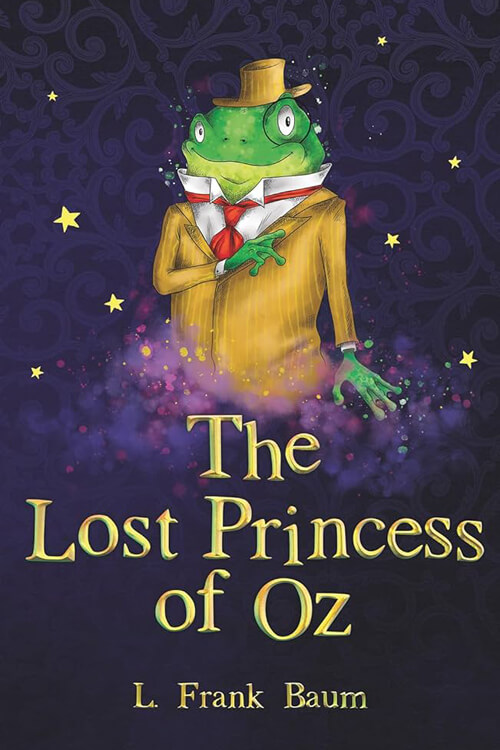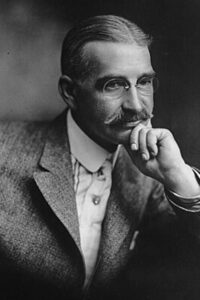
The Lost Princess of Oz
It was Dorothy who first discovered it. Dorothy was a little Kansas girl who had come to the Land of Oz to live and had been given a delightful suite of rooms in Ozma’s royal palace. Ozma loved Dorothy and wanted her to live as near her as possible so the two girls might be much together.
Dorothy was not the only girl from the outside world who had been welcomed to Oz and lived in the royal palace. There was another named Betsy Bobbin, whose adventures had led her to seek refuge with Ozma, and another named Trot, who had been invited, together with her faithful companion, Cap’n Bill, to make her home in this beautiful fairyland. The three girls had rooms in the palace and were great chums, but Dorothy was the dearest friend of their gracious Ruler, and only she dared to seek Ozma in her royal apartments at any hour. Dorothy had lived in Oz much longer than the other girls and had been made a Princess of the realm.
Betsy was a year older than Dorothy, and Trot was a year younger, yet the three were near enough of an age to become great playmates and have nice times together. It was while the three were talking together one morning in Dorothy’s room that Betsy proposed they make a journey into the Munchkin Country, one of the four great countries of the Land of Oz ruled by Ozma.
“I’ve never been there yet,” said Betsy Bobbin, “but the Scarecrow once told me it is the prettiest country in all Oz.”
“I’d like to go, too,” added Trot.
“All right,” said Dorothy, “I’ll go and ask Ozma. Perhaps she will let us take the Sawhorse and the Red Wagon, which would be much nicer than walking. This Land of Oz is a pretty big place when you get to all the edges of it.”
So she jumped up and went along the halls of the splendid palace until she came to the royal suite, which filled the front of the second floor. In a little waiting room sat Ozma’s maid, Jellia Jamb, who was busily sewing.
“Is Ozma up yet?” inquired Dorothy.
“I don’t know, my dear,” replied Jellia. “I haven’t heard a word from her this morning. She hasn’t even called for her bath or breakfast, and it is far past her usual time for them.”
“That’s strange!” exclaimed the little girl.
“Yes,” agreed the maid, “but no harm could have happened to her. No one can die or be killed in the Land of Oz, and Ozma is herself a powerful fairy. She has no enemies, as far as we know. Therefore, I am not worried about her, though I must admit her silence is unusual.”
“Perhaps,” said Dorothy thoughtfully, “she has overslept. Or she may be reading or working out new magic to do good to her people.”
“Any of these things may be true,” replied Jellia Jamb, “so I haven’t dared disturb our royal mistress. You, however, are a privileged character, Princess, and I am sure that Ozma wouldn’t mind if you went in to see her.”
Read or download Book
Lyman Frank Baum
Lyman Frank Baum (May 15, 1856 – May 6, 1919) was an American author best known for his children’s fantasy books, particularly The Wonderful Wizard of Oz, part of a series. In addition to the 14 Oz books, Baum penned 41 other novels (not including four lost, unpublished novels), 83 short stories, over 200 poems, and at least 42 scripts. He made numerous attempts to bring his works to the stage and screen; the 1939 adaptation of the first Oz book became a landmark of 20th-century cinema.
Biography.
Born and raised in upstate New York, Baum moved west after an unsuccessful stint as a theater producer and playwright. He and his wife opened a store in South Dakota, where he edited and published a newspaper. They then moved to Chicago, where he worked as a newspaper reporter and published children’s literature, coming out with the first Oz book in 1900. While continuing his writing, among his final projects, he sought to establish a film studio focused on children’s films in Los Angeles, California.
His works anticipated such later commonplaces as television, augmented reality, laptop computers (The Master Key), wireless telephones (Tik-Tok of Oz), women in high-risk and action-heavy occupations (Mary Louise in the Country), and the ubiquity of clothes advertising (Aunt Jane’s Nieces at Work).
Later life and work
With the success of Wizard on page and stage, Baum and Denslow hoped for further success and published Dot and Tot of Merryland in 1901. The book was one of Baum’s weakest, and its failure further strained his faltering relationship with Denslow. It was their last collaboration. Baum worked primarily with John R. Neill on his fantasy work beginning in 1904, but Baum met Neill a few times (all before he moved to California) and often found Neill’s art not humorous enough for his liking. He was exceptionally offended when Neill published The Oz Toy Book: Cut-outs for the Kiddies without authorization.
Baum reportedly designed the chandeliers in the Crown Room of the Hotel del Coronado; however, that attribution has yet to be corroborated. Several times during the development of the Oz series, Baum declared that he had written his last Oz book and devoted himself to other works of fantasy fiction based in other magical lands, including The Life and Adventures of Santa Claus and Queen Zixi of Ix. However, he returned to the series each time, persuaded by popular demand, letters from children, and the failure of his new books. Even so, his other works remained very popular after his death, with The Master Key appearing on St. Nicholas Magazine’s survey of readers’ favorite books well into the 1920s.
In 1905, Baum declared plans for an Oz amusement park. In an interview, he mentioned buying “Pedloe Island” off the coast of California to turn it into an Oz park. However, there is no evidence that he purchased such an island, and no one has ever been able to find any island whose name even resembles Pedloe in that area. Nevertheless, Baum told the press that he had discovered a Pedloe Island off the coast of California and purchased it to be “the Marvelous Land of Oz,” intending it to be “a fairy paradise for children.” Eleven-year-old Dorothy Talbot of San Francisco was reported to be ascendant to the throne on March 1, 1906, when the Palace of Oz was expected to be completed. Baum planned to live on the island, with administrative duties handled by the princess and her all-child advisers. Plans included statues of the Scarecrow, Tin Woodman, Jack Pumpkinhead, and H.M. Woggle-Bug. T.E. Baum abandoned his Oz Park project after the failure of The Woggle-Bug, which was playing at the Garrick Theatre in 1905.
His works anticipated such later commonplaces as television, augmented reality, laptop computers (The Master Key), wireless telephones (Tik-Tok of Oz), women in high-risk and action-heavy occupations (Mary Louise in the Country), and the ubiquity of clothes advertising (Aunt Jane’s Nieces at Work).






